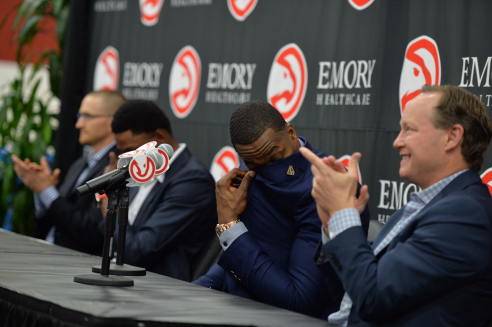The Atlanta Hawks deeply craved that coveted superstar free agent signing. In recent times, they have managed some very good free agent signings, with some going on to become All-Stars. They have also managed to turn some average role-player-type free agents into very good NBA basketballers and multi-millionaires.
However, every summer, that small pool of available NBA superstars always bypass the ATL. It is an issue that has in the past, caused the Hawks to overspend on talent.
Attracting that superstar free agent has always proved too difficult a task. In fact, the last superstar free agent to sign for the Hawks was back in 1996, when Dikembe Mutombo signed a five-year deal worth $55 million.
That was 20 years ago.
On July 12, 2016 all that changed.
The Hawks officially inked the signature of Dwight Howard, an eight-time NBA All-Star, three-time NBA Defensive Player of the year, five-time All-NBA first team, four-time NBA All-Defensive first team, Olympic Gold medalist and local boy turned NBA superstar.
The William Walker Recreation Center set an emotional scene the next day for the official introductory press conference. This was a place dear to Howard’s heart, a building where he spent countless hours honing his skills in readiness for the NBA. His dream was to one day play in this city. The Hawks had dreamt of bringing Howard home. The timing was now right. It became clear to everyone in the room. This was the biggest free agent signing in the history of the Atlanta Hawks.
Timing though, has always been the issue.
In the summer of 2012, desperate to escape Orlando, the Hawks were in the mix to trade for Howard. Ironically enough, the potential deal would have sent Al Horford, the man who Howard has just replaced, and Jeff Teague, the recently traded All-Star point guard, to Orlando. After eight productive years in Orlando, Howard was traded to the Lakers, in a four-team trade, to team up other NBA superstars in Kobe Bryant, Steve Nash and Pau Gasol. That dream move ended in a first round Western Conference Finals sweep at the hands of the San Antonio Spurs. That season marked his lowest scoring average since his second year in the NBA. His numbers across the board were down. Rumors suggested there was tension with his teammates, most notably with Kobe Bryant.
You could feel a change brewing.
Howard would become a free agent.
Just being in this building brings back chills. This area right here was home for me. My school was two minutes away. Every morning at 4:00, myself, my dad and my cousin ran out in the back on the track trying to make it to the NBA.
— An emotional Dwight Howard at his official introductory press conference
When head coach Mike Budenholzer (Bud) accepted the Atlanta job for the 2013-14 season, he wanted to bring Howard back home and play for the Hawks. As free agency began, Howard scheduled meetings with the LA Lakers, the Dallas Mavericks, the Golden State Warriors, the Houston Rockets and the Atlanta Hawks. Returning to the Lakers would earn Howard $118 million over five years, whereas the other teams could only offer a four-year contract worth $88 million. Money was not the deciding factor. Howard chose Houston, where he would team up with the young nucleus of James Harden, Chandler Parson, Jeremy Lin and Omer Asik. At the time, Howard admitted he was not ready or willing to come home and play in Atlanta. Coach Bud and the Hawks would have to wait.
His time in Houston, after the disastrous season in a Lakers uniform, raised serious question marks surrounding the hype of Howard. An afterthought on offense, Howard seemed to lack the necessary motivation and willingness needed to succeed and win an NBA championship. His happy-go-lucky demeanor would change with fewer touches and the trademark smile became less frequent. The dynamic duo of Superman and the Beard evolved into the James Harden show. After three years in Houston, Howard opted out of his final year, worth a guaranteed $23.2 million to test the open market. Atlanta again was on the shortlist, but the focus for the Hawks appeared to be on re-signing Al Horford and Kent Bazemore.
The Hawks were coming off their second successive playoff defeat by Cleveland. The feeling was the current roster had run its course. Change maybe the best option, except the Hawks recent success has been on the back of stability. Not returning Al and/or Kent would signal that change. A re-tooling perhaps.
The meeting was scheduled for just ten minutes, but lasted well over two hours. That conversation with coach Bud was all the convincing Howard needed. The focus had changed. No further meetings were needed. The Hawks had their prized recruit. Superman would return home on a three-year contract worth $70.5 million, an average of $23.5 million per year.
The future of Al Horford in Atlanta just became murky.
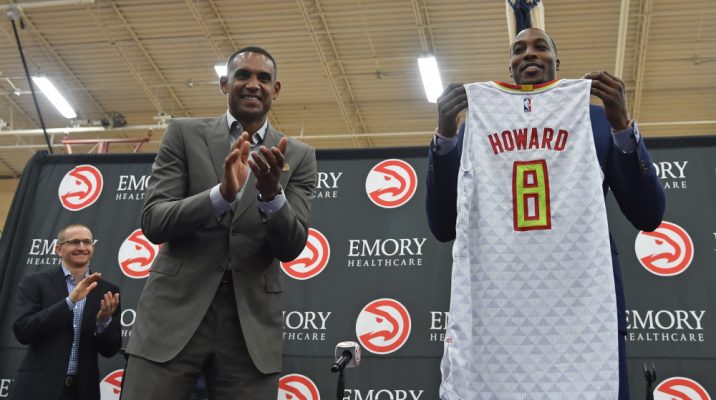
The slight re-tooling of the Hawks became evident on draft night. Atlanta would send their All-Star point guard Jeff Teague home to Indiana, trading for the 12th pick in the draft. Dennis Schroder, the 22 year old back-up point guard from Germany, had been waiting patiently for his chance to lead the team. The Hawks knew a decision on the two was imminent. This direction signaled a change. Atlanta added wings Taurean Prince (12th pick) and DeAndre Bembry (21st pick) via the draft and would eventually back-up Schroder with veterans Jarrett Jack and Malcolm Delaney. It was Howard’s signing though that effectively shaped the re-tooling, bringing an end to Al Horford’s 9-year career in Atlanta. Horford would eventually sign with Boston.
Coach Bud will now have to adjust the Hawks famous pace a space offense, needing to integrate a young point guard with a completely different type of center into the system. Al Horford was terrific in the pick and roll situations, with his range extending all the way to the three-point line. Last season, Horford made 218 shots (from 528 attempts) outside of 14 feet. Dwight Howard had only 8 shot attempts from that same distance. In fact, all of Howard’s 372 made field goals last season were inside of 14 feet, equating to 98.7% of his total field goal attempts at this distance. Furthermore, the majority of his field goal attempts was less than 5 feet from the basket (77.8% of total field goal attempts). Al Horford attempted 50.4% of his total field goals outside of 14 feet, connecting on 41.3% of his 528 attempts at this distance. The two are completely different centers. Dwight Howard cannot make field goals outside of 14 feet, nor is he comfortable taking those shots, whereas Al Horford prefers to shoot more shots from this distance (as the following charts will indicate). The game plan on offense will need to be adjusted with Howard in the line-up.
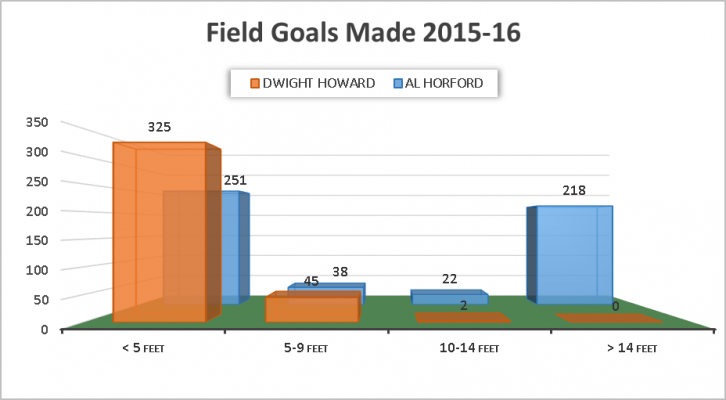
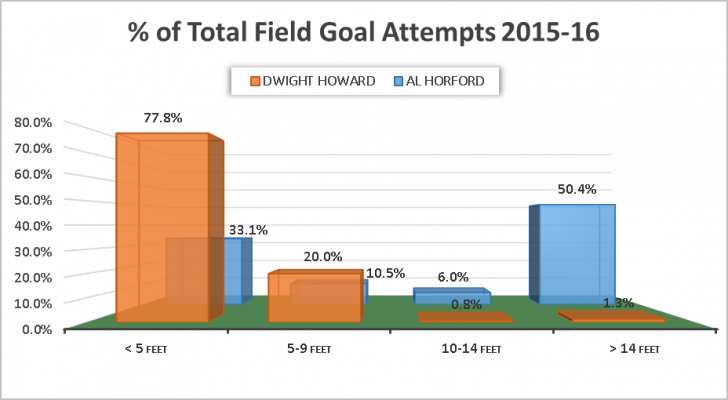
I am happy to be home. I know I am in a totally different place physically, mentally and spiritually than I was three years ago. I don’t think three years ago I would be the man I am today. This is really a new beginning for me. I’m happy to share that with my loved ones.
— Dwight Howard, on his return to Atlanta
If the Atlanta game plan is to use a pick-and-roll situation involving Dennis Schroder and Dwight Howard, they will need to use Howard where his strengths lay; within 5 feet of the basket. Howard shoots with high efficiency from this range, making 69.6% of his shots. It is no surprise his volume of total shots made is highest at this distance, making 87.4% of his total made shots within 5 feet. This would require Howard rolling to the rim where he is most effective and spacing out the rest of the floor with shooters. A tweak to the system for sure, but not an overwork by any means. It may even be a better offense, as the defense will now need to protect the rim and cover the outside shooters. There should be plenty of room for the speedy Schroder to operate where he is best; attacking the rim with either a finish or a dish or using his mid-range floater. It may even benefit Kyle Korver, whose struggles last season were attributed to a combination of injuries and opposition teams adding much tighter coverage.

Coach Bud says his forwards and centers are often interchangeable in his system. Therefore, the Hawks could even use Paul Millsap in the pick-and-roll situations, where his eFG% for last season was 48.8% on catch-and-shoot situations and 42% from mid-range. Rolling to the basket is even more effective for Millsap, as his eFG% increased to 58.4% inside of 8 feet and 62.7% at the rim. This scenario would leave two shooters on the wings for spacing, allowing Howard to roam near the paint for an easy dish, or the opportunity to crash the offensive boards. Whilst he was on the floor for the 2015-16 season, Howard grabbed 45.6% of his teams’ total offensive rebounds and grabbed 11.4% of available offensive rebounds. His 3.4 offensive rebounds per game ranked 3rd in the NBA, a clear strength.
Whichever tweak to the offense Bud uses, the best integration for Howard is clearly shots within 5 feet of the basket, and nothing outside of 10 feet. Last season, Howard made 92.2% of his 177 dunk attempts, 85.3% of his 109 alley oop attempts, 59.7% of his 201 layups and 57.9% of his 38 tip shots. He evidently prefers a hook shots (152 attempts at 44.7%) to a jump shot (52 attempts at 11.5%). It is safe to say his sweet spots are either at the rim or post-ups leading to a hook shot. Since one of Howard’s issues in both Houston and LA was a lack of touches on the offensive end, the new offensive system needs to use Howard as effectively as possible in his sweet spot areas.
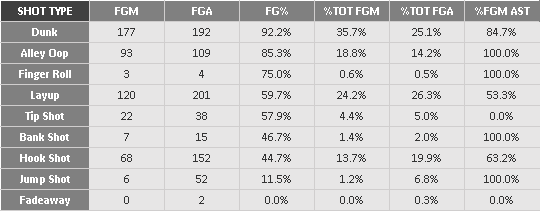
It’s great to have somebody who is going to roll and put pressure on the rim and have shooting around him. I think it’s going to work well. In a lot of ways, we’ve adjusted to who we’ve had the first three years and in some ways, it will be going back to what I know maybe even better and maybe even more comfortable with having someone who can put that kind of pressure on the rim.
— Mike Budenholzer, on the signing of Dwight Howard
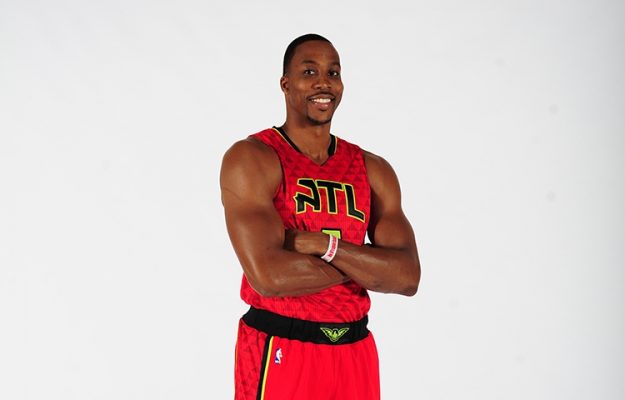
Under Mike Budenholzer, the Atlanta Hawks have become one of the premier defensive units in the NBA. Last season, they ranked #3 in steals (9.1 per game), #5 in blocks (5.9 per game), #1 in opponents FG% (43.2%) and opponents 2P% (46.9%), #6 in opponents 3P% (33.8%) and PPG allowed (99.2). Their 2nd best defensive rating allowed just 101.4 points per 100 possessions. In the Defensive Four Factors, they ranked in the top 5 in three of these categories; eFG%, TOV% (turnovers forced per 100 plays), FT/FGA (how often the opposing team gets to the line).

The one glaring weakness for the Hawks is rebounding the basketball. Atlanta ranked 24th in total rebounds last season averaging 42.1 per game. On the offensive end, they ranked 30th grabbing just 8.3 per game. They were better on the defensive end, grabbing 33.8 per game, but this still ranked them 13th. Their defensive rebound percentage of 74.6 ranked 25th in the league.
If the Hawks are to challenge for an NBA championship, they have to dramatically improve their rebounding.
This will be the one area Dwight Howard will make the biggest improvement. Of active NBA players, Howard ranks 3rd in total rebounds (11,149), 4th in defensive rebounds (8,053) and 5th in offensive rebounds (3,096). Of his 12 NBA seasons, only 1 time did he finish outside of the top 10 in total rebounds and defensive rebounds (2014-15), and 3 times did he finish outside the top 10 in offensive rebounds (2011-12, 2012-13, 2014-15). He led the NBA in total rebounds and offensive rebounds on 6 occasions, and on 1 occasion he led the league in offensive rebounds. His career average is 12.7 rebounds per game, of which 9.2 are on the defensive end. Last season he averaged more defensive rebounds per game (8.4) than Al Horford averaged in total rebounds per game (7.3). In reality, he will give the Hawks and additional 5.4 more rebounds per game than Al Horford, or an extra 443 on an 82-game season (based on 2015-16 season). That would have moved the Hawks up 22 places to 2nd in the NBA in total rebounds.
Quite simply, Dwight Howard is a rebounding machine.
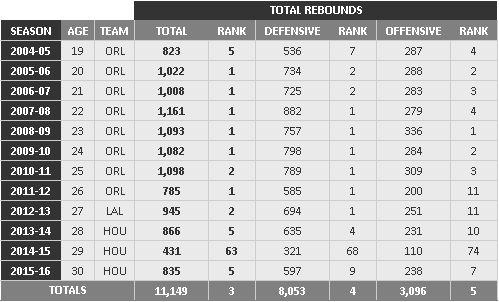
Dwight Howard is motivated. Highly motivated. He wants to prove all the doubters wrong. He is healthy and has been working out every day since the end of last season, apart from a 5-day trip to Mexico. There are no issues with his back (herniated disc surgery in April 2012), nor his knees (torn MCL and meniscus over past two years). He accepts that over the years, his public image has been tarnished. He is driven to change this perception. He is determined to once again be a dominant big man in the NBA.
Above all, Dwight Howard has a deep yearning to bring an NBA championship to Atlanta.
The city where he was born and raised.
The city he once again calls home.
I am humbled and honoured to be an Atlanta Hawk and to represent our city. This opportunity is a dream come true and a blessing for me and my family. I look forward to pouring my heart out every night for this city, my teammates and the fans.
— Dwight Howard, addressing the media about his return home.
All statistics sourced from NBA.com and Basketball-reference.com

